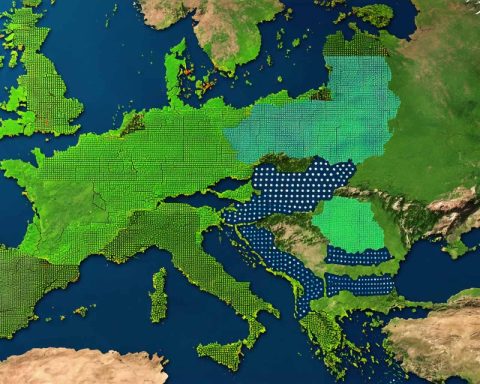- Tidal energy is a reliable and sustainable energy source, harnessing the gravitational pull between Earth, moon, and sun.
- The proposed tidal lagoon in Swansea, Wales, showcases how tides can be utilized to generate electricity for thousands of homes.
- Tidal power systems are durable and predictable, with lifespans often exceeding 100 years and minimal ecological impact.
- Initial high investment costs are balanced by low operational expenses and environmental benefits, with potential cost reductions as technology advances.
- Projects like Swansea’s emphasize community involvement and harmony with nature, aligning with Europe’s Green Deal goals.
- Coastal cities have a unique opportunity to lead in sustainable energy by adopting tidal power innovations.
- Tidal power offers a promising solution in combating climate change, providing a renewable energy source for future generations.
Turquoise waves crash rhythmically against ancient cliffs, as seagulls circle overhead, their cries carried on the brisk ocean breeze. Yet beneath this picturesque coastal scene lies an untapped powerhouse poised to redefine how cities harness clean energy: tidal power.
Tidal energy, a formidable force that for centuries has shaped our shores, now emerges as a beacon of hope for a sustainable future. Unlike its unpredictable solar and wind counterparts, tidal energy thrives on the dependable gravitational dance between Earth, moon, and sun. This reliability makes it a prime candidate for integration into the energy grids of coastal metropolises.
In the bustling harbor city of Swansea, Wales, plans unfurl for a revolutionary tidal lagoon—a sprawling horseshoe-shaped structure nestled offshore. As tides ebb and flow, they funnel seawater through turbines, generating electricity to illuminate thousands of homes. Swansea’s bold venture aims to spark a tidal energy movement that could ripple across the globe.
Why tidal power? The advantages are compelling. Tidal energy systems boast remarkable longevity, often exceeding 100 years, and exhibit a predictability unmatched by other renewables. With minimal ecological impact, such systems harmonize with marine ecosystems, allowing life to thrive rather than threatening its delicate balance.
The challenge, then, lies in capitalizing on this potential while surmounting the initial financial hurdles. The technology requires substantial upfront investment, but once operational, offers cost-effective, renewable energy with low operational costs and environmental benefits. As expertise grows, costs may diminish, making tidal power more accessible to coastal cities worldwide.
Visionary projects like Swansea’s emphasize community involvement and environmental stewardship, showcasing how innovation can thrive alongside nature. Here lies the essence of Europe’s Green Deal as the continent seeks to neutralize carbon emissions by 2050.
The takeaway? In our quest for sustainable energy, the ocean’s rhythmic tides present an opportunity to lead us toward a cleaner, more resilient future. Coastal cities, where land meets sea, are uniquely poised to spearhead this watery revolution. By harnessing the power of tides, these urban centers can become blueprints for a sustainable energy paradigm, lighting the way for generations to come.
Together, let us look to the ocean not just as an expanse of water but as a source of unending energy and promise. With innovation and determination, tidal power could turn the tide against climate change, offering a beacon of hope for our shared planet.
Discover the Untapped Power of the Ocean: How Tidal Energy Could Transform Our Future
Exploring Tidal Energy: An Overview
Tidal energy, though ancient in its natural existence, represents a frontier in sustainable technology. As the world reels from climate change impacts, the prospect of harnessing the ocean’s rhythmic tides offers a sustainable path forward, particularly for coastal cities. Unlike solar and wind energy, which can vary with weather conditions, tidal energy offers a predictable and reliable source of renewable power.
What Makes Tidal Energy Unique?
Tidal energy is derived from the gravitational interaction between the Earth, moon, and sun, leading to predictable tidal movements. This predictability translates into a reliable energy source that cities can depend on. Here’s what sets tidal energy apart:
– Predictability: Tides are reliable and can be forecast years in advance.
– Longevity: Tidal systems can outlast other renewable infrastructures with operational lifespans beyond 100 years.
– Eco-friendly: Designed to coexist sustainably with marine ecosystems.
Real-World Use Cases and Market Trends
Tidal power projects like the Swansea Bay Tidal Lagoon in Wales lead the charge in turning tidal energy from a concept into reality. Similar projects in other locations—including the MeyGen project in Scotland and the Sihwa Lake Tidal Power Station in South Korea—continue to develop, offering insights into the scalability and feasibility of this technology.
Market Forecast
The global tidal energy market is projected to grow significantly within the next decade, according to market analysis by [ResearchAndMarkets](https://www.researchandmarkets.com). With technological advancements and increased investment, the tidal energy sector is poised to play a pivotal role in the renewable energy mix.
Challenges and Limitations
Despite the potential, tidal energy faces several hurdles:
– High Initial Costs: The capital investment for constructing tidal power plants is substantial.
– Geographic Limitations: Tidal power is viable only in areas with high tidal ranges.
– Ecological Considerations: Careful planning is required to minimize impacts on marine life and habitats.
How Tidal Energy Works: A Technological Perspective
1. Turbines and Generators: Tidal movements drive underwater turbines, similar to wind turbines, that generate electricity.
2. Barrage Systems: These act as dams, capturing water at high tide and releasing it through turbines during low tide.
3. Dynamic Tidal Power: A newer concept that extends dams perpendicularly from the coast into the sea.
Pros and Cons Overview
Pros:
– Renewable, predictable energy supply
– Minimal operational costs after initial setup
– Long lifespan of infrastructure
Cons:
– High upfront cost
– Potential ecological disturbances
– Limited suitable locations
Actionable Recommendations
1. For Policymakers: Incentivize initial investments and research to reduce costs and enhance technological advances.
2. For Researchers: Focus on innovating eco-friendly designs to protect marine ecosystems.
3. For Communities: Engage in awareness programs to foster support for local tidal energy projects.
Conclusion
Tidal power presents a compelling avenue in the quest for sustainable energy. By harnessing the ocean’s natural rhythms, coastal cities can pave the way toward a cleaner, more resilient energy future. As we strive to meet ambitious climate goals, embracing tidal power could indeed be a key element in turning the tide against global warming. Explore more about renewable energy solutions at [IEA.org](https://www.iea.org).
Remember, the ocean’s energy is vast and, if harnessed responsibly, could light up our cities and our path to a more sustainable planet.














